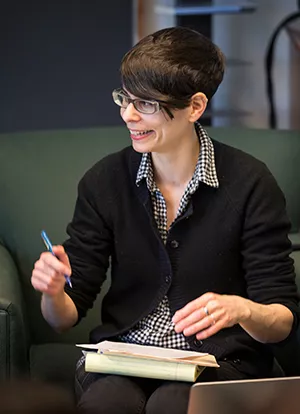Uncovering the History of Innovative Teaching of Literature in Higher Ed

Rachel Sagner Buurma '99
In their book, The Teaching Archive: A New History For Literary Study, Associate Professor of English Literature, Rachel Sagner Buurma ‘99 and co-author, Laura Heffernan, Associate Professor of English at the University of North Florida, tell a new story about how literature was taught at colleges and universities in the 20th century.
“But this isn't just an English literature story, it’s a story for anyone interested in higher education,” says Buurma.
A common misconception in higher education is that at most institutions professors have been focused on research, and are not invested in teaching or committed to innovation in education. But researching materials like class plans, syllabi, handouts, and graded papers T. S. Eliot, I. A. Richards, Edith Rickert, Edmund Wilson, J,. Saunders Redding, Josephine Miles, and Simon J. Ortiz, Buurma and Heffernan learned that experimentation and invention in the classroom has been more the norm than the exception.
They discovered teachers and students throughout the twentieth century applied quantitative approaches to the study of literature by writing books and articles together, creating collaborations between college students and high school teachers, and engaging local communities in reading projects.
Buurma and Heffernan’s research challenges the assumption that in literary studies until the 1970s college literature professors taught only valued “classics” by canonical white writers like Shakespeare and Dickens, while avoiding modern literature and literature by Black, Indigenous, and other writers of color, and by women. The authors found that in some institutions, these works were central to the curriculum.
“If you look at Historically Black Colleges and Universities (HBCUs) like Hampton University in the 1920s and 30s, you see that the American literature syllabus is equally divided between books by Black authors and books by white authors... giving students a history of African American literature that showed how it was a central part of American literature,” says Buurma. And assigned readings in Simon J. Ortiz’s American Indian Arts class at Marin College in the 1970s included anthologies of new poetry by Indigenous writers as well as classic autobiographies and stories, showing not just the importance of the literary tradition, but the newest work that might inspire students to pursue their own writing.
The authors believe that The Teaching Archive will provide administrators and teachers with the new history of how literary scholars and other teaching professionals have responded to the needs of their students and society.
For example, in 1916 Eliot began teaching 19th century literature to working-class students in evening extension courses at University College London. Teaching a traditional classical author every week, he determined that his students didn't have the time to connect with the authors and the major themes of their works. So Eliot adjusted and began teaching “great authors” as working writers- writing to deadlines, writing to get paid, and collaborating with the people around them. Eliot believed that his students, who worked in groceries and daycares and attended school at night to better their lives, could relate and understand these great writers weren’t so different from themselves.
Buurma, a graduate of the class of 1999, says the Swarthmore Honors program is an example of the kinds of student-centered, engaged teaching documented in the book.
“Swarthmore is a place that values teaching,” she says, “And in the Honors seminar, students sit alongside professors making knowledge together. When Dr. Heffernan and I turned to our archival research, we had that model in mind, and we were excited when we found it in classrooms at many different kinds of institutions.”
Heffernan says Buurma’s time in Swarthmore classrooms lives on and influences her teaching and students as well. “Swarthmore teaching materials have made their way via Rachel to me, to my undergraduate classrooms, and to my student’s classrooms where they are teaching in public schools in Jacksonville, Florida,” says Heffernan.



